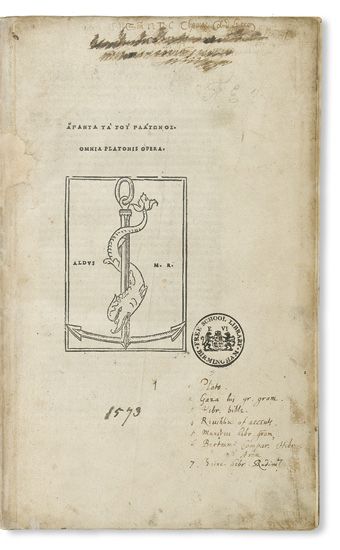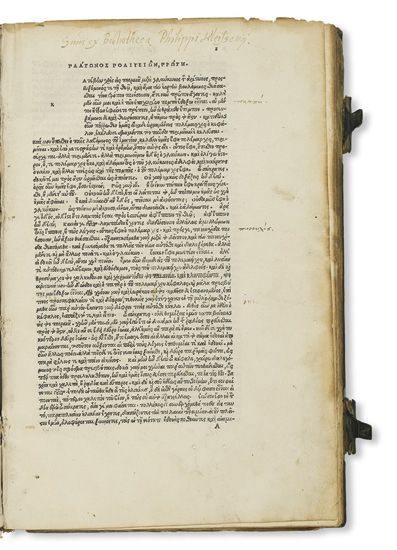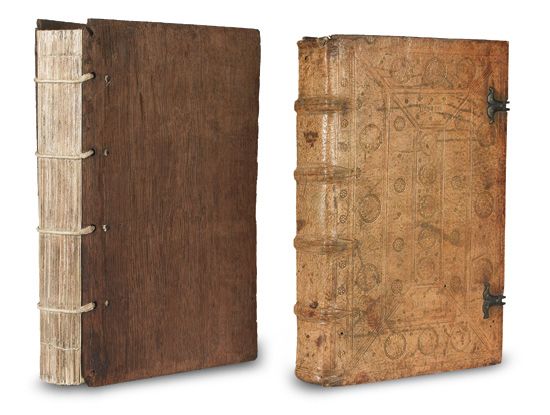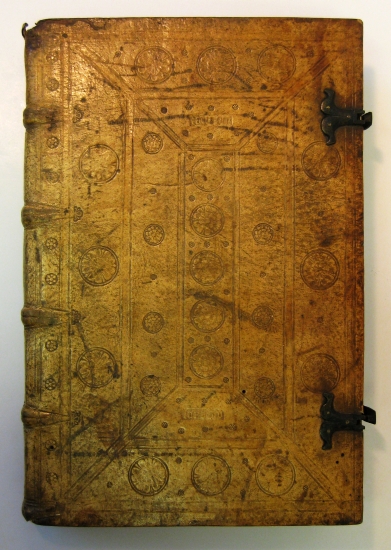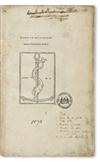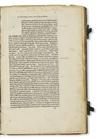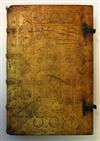Sale 2291 - Lot 92
Price Realized: $ 38,000
Price Realized: $ 45,600
?Final Price Realized includes Buyer’s Premium added to Hammer Price
Estimate: $ 30,000 - $ 50,000
PLATO. Omnia Platonis opera. Greek text, edited by Aldus Manutius and Marcus Musurus. [32], 502; 439, [1] pages; lacks the final blank in Volume 1. 2 volumes. Folio, 312x198 mm, contemporary English(?) quartered oak boards, resewn with spine uncovered, modern vellum endleaves, contents unobtrusively washed, with residual soiling and old scored inscriptions on title; and 301x200 mm, contemporary German pigskin over wooden boards, blind-tooled to panel design filled in with 'laus deo' and rosette stamps, brass catches and clasps, top of spine worn, minor stains on fore edges, few wormholes in blank lower margin of opening leaves, few early marginalia; cloth folding cases. Volume 1 with signature of Thomas Colm of Oxford dated 1573, 17th-century ownership inscription of Hendricus Ffeild, and 19th-century bookplate and stamp of King Edward's School, Birmingham; Volume 2 with early ownership inscriptions of Johannes (or Johann?) Lang of Erfurt and Philippus Kleissenius. (Venice: House of Aldus and Andrea of Asola, September 1513)
Additional Details
first edition in the original greek of the works of Plato, one of the most important productions of the Aldine press and the last of the Greek first editions produced under the supervision of Aldus. Renouard, pages 62(4); New UCLA 114.
The boards on Volume 1 display characteristics of bindings in Greek style ('alla Greca') popular among humanist collectors of Greek texts in the first half of the 16th-century, primarily in Italy, where they were produced by Greek émigré craftsmen using their native techniques. Contemporary hybrid imitations with a Greek-style exterior over Western European sewing structures are known in France and Germany, though not in England. According to an analysis by the conservator and bookbinding historian Nicholas Pickwoad, 'these wooden boards are rare if not unique evidence of a sixteenth-century English attempt to produce an alla greca binding. Amongst the characteristic external features of Greek-style bindings were grooves cut into the head, tail and fore edges of the boards and a fastening system which used pins inserted into the edge of one board over which metal rings were hooked, attached by leather straps to the other board. Both features are found on these boards . . . The quartered oak used for the boards . . . was typical of English bindings . . . There is no surviving evidence of the material used for the sewing supports, but the existence of leather wedges or pegs to secure the slips from the (now missing) sewing supports and the surviving cord endband cores indicates an English provenance and is in itself an extremely unusual technique . . . It is difficult to date such boards with any precision in the absence of decoration, but the use of tongued mitres and trimmed-out turn-ins, evidenced by the knife-cuts visible around the outer edges of the inside of the back board, indicate a date in the first half of the sixteenth century, and quite probably in the first quarter of the century.'
The inscription "de bibliotheca Johannis Langi Erphurdiensis" in Volume 2 is also found in a copy of the 1498 Aldine Aristophanes at the Royal Library in Stockholm, and tentatively ascribed by Collijn to the Erfurt reform theologian and Greek scholar Johann Lang (circa 1486-1548); cf. Katalog der Inkunabeln der Kgl. Bibliothek in Stockholm 92. See also Contemporaries of Erasmus II, 287-88.
The boards on Volume 1 display characteristics of bindings in Greek style ('alla Greca') popular among humanist collectors of Greek texts in the first half of the 16th-century, primarily in Italy, where they were produced by Greek émigré craftsmen using their native techniques. Contemporary hybrid imitations with a Greek-style exterior over Western European sewing structures are known in France and Germany, though not in England. According to an analysis by the conservator and bookbinding historian Nicholas Pickwoad, 'these wooden boards are rare if not unique evidence of a sixteenth-century English attempt to produce an alla greca binding. Amongst the characteristic external features of Greek-style bindings were grooves cut into the head, tail and fore edges of the boards and a fastening system which used pins inserted into the edge of one board over which metal rings were hooked, attached by leather straps to the other board. Both features are found on these boards . . . The quartered oak used for the boards . . . was typical of English bindings . . . There is no surviving evidence of the material used for the sewing supports, but the existence of leather wedges or pegs to secure the slips from the (now missing) sewing supports and the surviving cord endband cores indicates an English provenance and is in itself an extremely unusual technique . . . It is difficult to date such boards with any precision in the absence of decoration, but the use of tongued mitres and trimmed-out turn-ins, evidenced by the knife-cuts visible around the outer edges of the inside of the back board, indicate a date in the first half of the sixteenth century, and quite probably in the first quarter of the century.'
The inscription "de bibliotheca Johannis Langi Erphurdiensis" in Volume 2 is also found in a copy of the 1498 Aldine Aristophanes at the Royal Library in Stockholm, and tentatively ascribed by Collijn to the Erfurt reform theologian and Greek scholar Johann Lang (circa 1486-1548); cf. Katalog der Inkunabeln der Kgl. Bibliothek in Stockholm 92. See also Contemporaries of Erasmus II, 287-88.
Exhibition Hours
Exhibition Hours
Aliquam vulputate ornare congue. Vestibulum maximus, libero in placerat faucibus, risus nisl molestie massa, ut maximus metus lectus vel lorem.



